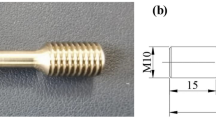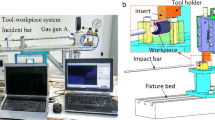Abstract
The adiabatic shear band (ASB) is easily generated in high-speed cutting, as well as the serrated chip. The main factors are high temperature and elastoplastic instability. An adiabatic shear energy dissipation model was established and analyzed. A series of milling experiments were systematically conducted with cryogenic and conventional cooling. Meanwhile, the characteristics of the workpiece and chip were investigated and compared. The results show that under the conventional cooling, at the cutting speed of 150 m/min, the ASB and generated serrated chip can be produced with the high-frequency oscillation cutting force. In cryogenic, the chip is serrated at all kinds of cutting speed, especially high speed, and the sawtooth is regular with no obvious ASB. The serrated chip formation is mainly associated with brittle cutting in cryogenics. When the cutting parameters are unchanged, the energy dissipation is mainly determined by the main cutting force and shear strength. Compared with the conventional cooling process, the energy dissipation in cryogenic is more than the former one, and the ability of producing instantaneous adiabatic shear is weaker. Furthermore, due to the instantaneous cold brittleness of liquid nitrogen, the generating condition of the ASB is not satisfied in the shear zone.
Similar content being viewed by others


References
Alborz S, Vimal D, Stephen TN (2016) Investigation of the effects of cryogenic machining on surface integrity in CNC end milling of Ti–6Al–4V titanium alloy. J Manuf Process 21:172–179
Raza S W, Pervaiz S, Deiab I(2014) Tool wear patterns when turning of titanium alloy using sustainable lubrication strategies 15(9):1979–1985
Ye GG, Xue SF, Ma W, Jiang MQ, Ling Z, Tong XH, Dai LH (2012) Cutting AISI 1045 steel at very high speeds. Int J Mach Tool Manu 56:1–9
**e J, Bayoumi A, Zbib H (1998) FEA modeling and simulation of shear localized chip formation in metal cutting. Int J Mach Tool Manu 8:1067–1087
Wang BF, Li J, Sun JY (2014) Adiabatic shear bands in Ti-6Al-4V alloy with lamellar microstructure. J Mater Eng Perform 23(5):1896–1903
Hou Z, Komanduri R (1997) Modeling of thermomechanical shear instability in machining. Int J Mech Sci 39(11):1273–1275
Li GH, Wang MJ, Duan CZ (2009) Adiabatic shear critical condition in the high-speed cutting. J Mater Process Technol 209(3):1362–1367
Komanduri R, Schroeder T (1986) On shear instability in machining a nickel-iron base superalloy. J Eng Ind Trans ASME 108(2):93–100
Gente A, Hoffmeister H, Evans C (2001) Chip formation in machining Ti-6Al-4V at extremely high cutting speeds. CIRP Ann Manuf Technol 50(1):49–52
Barry J, Byrne G (2002) The mechanisms of chip formation in machining hardened steels. J Manu Sci Eng 124(3):528–535
Molinari A, Soldani X, Miguelez MH (2013) Adiabatic shear banding and scaling laws in chip formation with application to cutting of Ti-6Al-4V. J Mech Phys Solids 61(11):2331–2359
Ren Y, Yu XD, Tan CW, Li XS (2019) Dynamic mechanical properties and adiabatic shearing behavior of the shock prestrained Ti-6Al-4V alloy having bimodal microstructure. J Alloys Compd 773:1054–1063
Gu LY (2018) Critical condition prediction of adiabatic shear fracture in high-speed cutting TA2 alloy. Int J Adv Manuf Technol 94(5-8):2981–2991
Mozammel M (2017) Multi-response optimization of end milling parameters under through-tool cryogenic cooling condition. Measurement 111:134–145
Lee I, Bajpai V, Moon S, Byun J, Lee Y, Park HW (2015) Tool life improvement in cryogenic cooled milling of the preheated Ti–6Al–4V. Int J Adv Manuf Technol 79:665–673
Park KH, Suhaimi MA, Yang GD (2017) Milling of titanium alloy with cryogenic cooling and minimum quantity lubrication (MQL). Int J Precis Eng Manuf 18(1):5–14
Park KH, Yang GD, Suhaimi MA (2015) The effect of cryogenic cooling and minimum quantity lubrication on end milling of titanium alloy Ti-6Al-4V. J Mech Sci Technol 29(12):5121–5126
Shokrani A, Dhokia V, Newman ST (2016) Comparative investigation on using cryogenic machining in CNC milling of Ti-6Al-4V titanium alloy. Mach Sci Technol 20(3):475–494
Wang FB, Liu JK, Shu QL (2017) Milling wear of carbide tool for processing nickel-based alloy in cryogenic based on the entropy change. Int J Adv Manuf Technol 90:1703–1713
Wang FB, Liu JK, Shu QL (2017) Research on tool wear of milling nickel-based superalloy in cryogenic. Int J Adv Manuf Technol 91:3877–3886
Grady DE (1992) Properties of an adiabatic shear band process zone. J Mech Phys Solids 40(6):1197–1215
Grady DE (2017) Physics of shock and impact. IOP Publishing, Bristol, pp 131–204
Jiang J, Li YQ, Zhang ZY (1991) Manufacturing technology of titanium alloy parts. National Defence Industry Press, Bei**g, pp 25–101
Wang J Y, Ge Z M (1985) Aviation titanium alloy. Shanghai Science and Technology Press, Shanghai.pp:31–98
Oxlev PLB (1989) Mechanics of machining: an analytical approach to assessing machinability. Halsted Press, Chichester, pp 100–176
Bang J, Byrne G, Lennon D (2001) Observations on chip formation and acoustic emission in machining Ti-6A1-4V alloy. Int J Mach Tool Manu 41:1055–1070
Ginting A, Nouari M (2009) Surface integrity of dry machined titanium alloys. Int J Mach Tool Manu 49(3–4):325–332
Cotterell M, Byrne G (2008) Dynamics of chip formation during orthogonal cutting of titanium alloy Ti-6A1-4V. CIRP Ann Manuf Technol 57:93–96
Huang XD, Zhang XM, Mou HK et al (2014) The influence of cryogenic cooling on milling stability. J Mater Process Technol 214:3169–3178
Ravi S, Pradeep Kumar M (2011) Experimental investigations on cryogenic cooling by liquid nitrogen in the end milling of hardened steel. Cryogenics 51:509–515
Sharm VS, Dogra M, Suri NM (2009) Cooling techniques for improved productivity in turning. Int J Mach Tool Manu 49:435–453
Acknowledgements
This research was partially supported by the natural science foundation project of Liaoning province (No. 20170540787), the Liaoning key fund of national natural science fund (No. U1608251), and the basic science and research project of Liaoning province (No. LG201711).
Author information
Authors and Affiliations
Corresponding author
Additional information
Publisher’s note
Springer Nature remains neutral with regard to jurisdictional claims in published maps and institutional affiliations.
Rights and permissions
About this article
Cite this article
Wang, F., Wang, Y. Effect of cryogenic cooling on adiabatic shearing in processing titanium alloy. Int J Adv Manuf Technol 102, 3587–3596 (2019). https://doi.org/10.1007/s00170-019-03380-3
Received:
Accepted:
Published:
Issue Date:
DOI: https://doi.org/10.1007/s00170-019-03380-3


